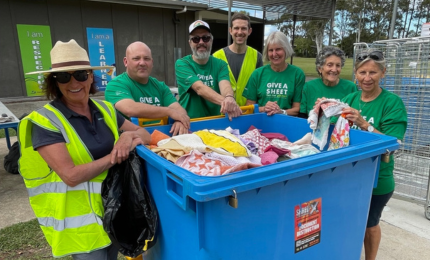Textile Recycling
To celebrate World Environment Day 2023, Noosa Council partnered with Blocktexx, Vinnies and Sunshine Coast Council to deliver a community textile recovery collection event, ‘Give a Sheet for the Planet’.

Clean clothing in good sellable condition was collected and resold by St Vincent de Paul stores.
Why are textiles and clothing a problem?
- Every year in Australia, one million tonnes of textile waste ends up in landfill. This does not breakdown.
- Global textile waste is predicted to hit 140 million tonnes by 2030.
- Australians acquire an average of 27 kgs of new clothing per person each year. We discard around 23 kilograms of clothing to landfill each year (the University of Queensland).
- Australia is the second highest consumer of textiles per person in the world, after the United States of America.
- The clothing industry contribute up to 5% of global carbon emissions more than all international flights and maritime shipping combined (WEF 2021).
- One kilogram of unwanted textile waste processed by BlockTexx is equivalent to 30kgs of CO2 emissions.
Who is BlockTexx and what do they do?
- BlockTexx is a world-leading clean technology company with Australia’s first textile resource recovery facility in Logan.
- BlockTexx’s S.O.F.T. (separation of fibre technology) process takes polyester and cotton blended fabric and turns it into high quality recycled PET pellets and natural cellulose powder that can be used to manufacture new items.
- One kilogram of unwanted textile waste processed by BlockTexx is equivalent to 30kgs of CO2 emissions. That means one truck load of linen collected, will have diverted 10 tonnes of textile waste from landfill and will have removed carbon emissions equivalent to taking 65 cars off the road for a year*
- EPA NSW figures state the average family car emits 4.6 tonnes per year of CO2e. BlockTexx offsets 30 tonnes of CO2e for every tonne of textile waste processed – the equivalent to 6.5 average family cars.
- For more information about BlockTexx: go to www.blocktexx.com
Frequently Asked Questions
-
Charities can only sell quality donations that are not stained, broken or torn.
In 2019 charities in Australia had over 60,000 tonnes of unusable donations which ended up in landfill.
“The best advice is that if you wouldn’t give it to a friend, don’t give it to a charity,” National Association of Charitable Recycling Organisations chief Omer Soke.
-
Australia is one of the world's most wasteful countries in the developed world. An estimated 6 tonnes of clothes are thrown out every ten minutes in Australia.
-
You can shop pre-loved, it’s good for the environment, it saves resources and saves you money.
If you do buy something new, buy good quality timeless pieces that you can wear for many years.
